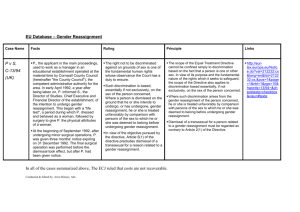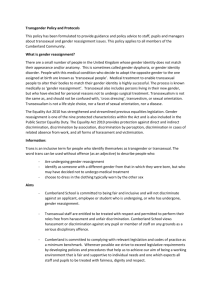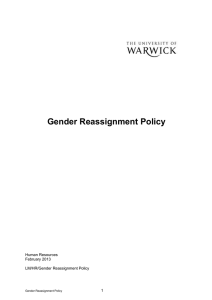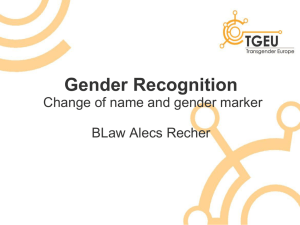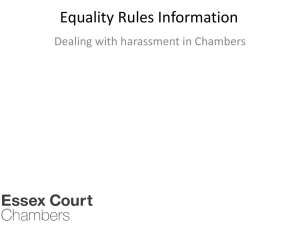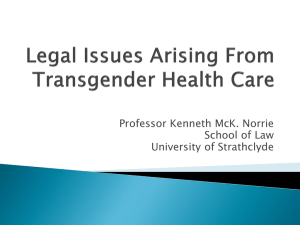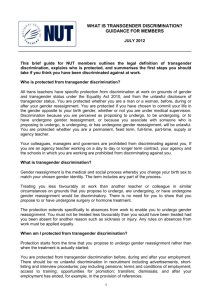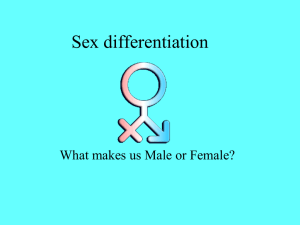Gender Reassignment Policy
advertisement
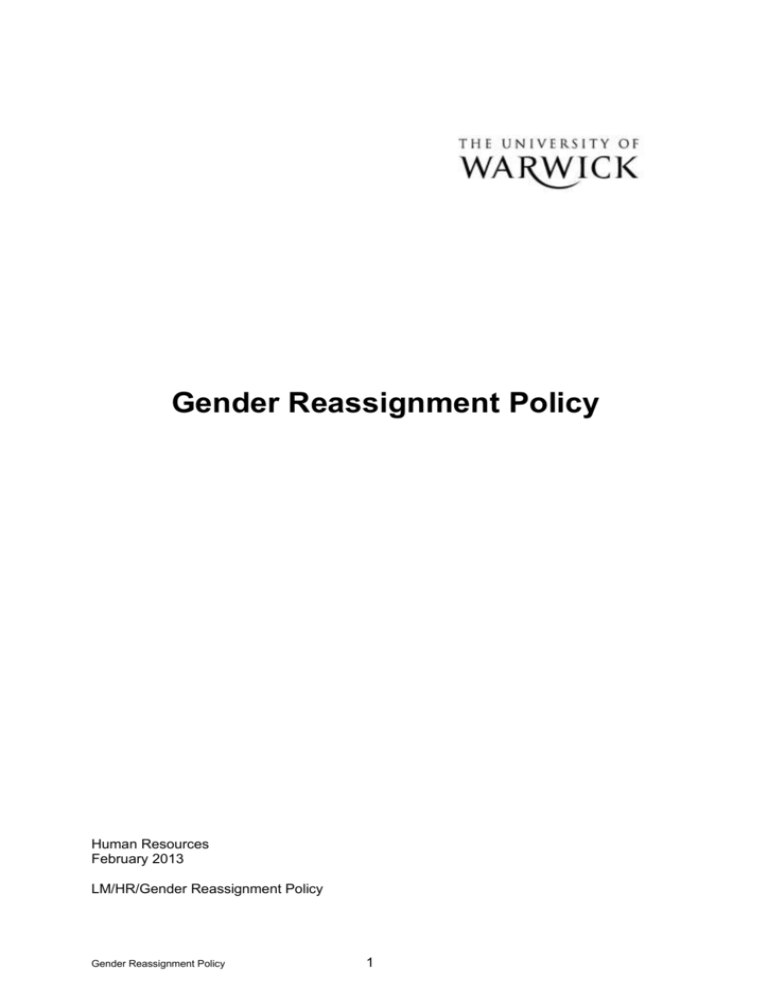
Gender Reassignment Policy Human Resources February 2013 LM/HR/Gender Reassignment Policy Gender Reassignment Policy 1 1.0 INTRODUCTION 1.1 This policy has been formulated to provide general guidance and policy advice to staff, students and managers about transsexual and gender reassignment issues. 1.2 This policy applies to all staff, including part time teachers, casual staff, temporary staff from Employment Agencies and Contractors working on campus. 1.3 Trans is an inclusive term for people who identify themselves as transgender or transsexual. The word trans can be used without offence (as an adjective) to describe people who are undergoing gender reassignment identify as someone with a different gender from that in which they were born, but who may have decided not to undergo medical treatment choose to dress in the clothing typically worn by the other sex 2.0 AIMS 2.1 The University of Warwick is committed to being a fair and inclusive employer and will not discriminate against an applicant, employee or student who is undergoing, or who has undergone, gender reassignment. 2.2 Transsexual staff and students are entitled to be treated with respect and permitted to perform their roles free from harassment and unfair discrimination. The University of Warwick views harassment or discrimination against any student or member of staff on any grounds as a serious disciplinary offence. 2.3 We are committed to complying with relevant legislation and codes of practice as a minimum benchmark. Wherever possible we strive to exceed legislative requirements by developing policies and procedures that help us to achieve our aim of being a working environment that is fair and supportive to individual needs and one which it expects all staff and students to be treated with fairness, dignity and respect. 3.0 RESPONSIBILITIES 3.1 All members of the University and University staff are responsible for helping to ensure that individuals do not suffer any form of discrimination as a result of their gender reassignment, and that they are supportive of individual needs. Every person working for the University will be accountable for the operation of this policy as they carry responsibility for their own behaviour and actions, on and off site during working hours or any activity associated with their employment or membership of the University. 3.2 All staff in a managerial position are responsible for seeking to prevent any infringement of the policy amongst the staff for which they are responsible and taking action where appropriate. 3.3 Human Resources and Campus Affairs/Academic Office will be responsible for providing training on this policy. Gender Reassignment Policy 2 4.0 WHAT IS GENDER REASSIGNMENT? 4.1 There are a small number of people in the United Kingdom whose gender identity does not match their appearance and/or anatomy. This is sometimes called gender dysphoria, or gender identity disorder. People with this medical condition who decide to adopt the opposite gender to the one assigned at birth are known as ‘transsexual people’. Medical treatment to enable transsexual people to alter their bodies to match their gender identity is highly successful. The process is known medically as ‘gender reassignment’. Transsexual also includes persons living in their new gender, but who have elected for personal reasons not to undergo surgical treatment. 5.0 HOW IS GENDER TRANSITION ACHIEVED? 5.1 Diagnosis of transsexualism may take a matter of months or a period of years. Transition is achieved by the person undergoing gender reassignment. The process consists of counselling, followed by medication to alter the body and physical characteristics. During the early part of the medical process it is possible the individual may display characteristics of both genders. The final stage for some individuals is to undergo surgery. Not all persons going through gender reassignment undergo surgery, it is a personal choice and not a key criterion in the process of definition to gender change. 5.2 Transsexualism is not the same as, and should not be confused with, ‘cross dressing’, transvestism, or sexual orientation. Transexualism is not a life style choice, nor a facet of sexual orientation, nor a disease. 6.0 WHAT IS GENDER RECOGNITION? 6.1 The Gender Recognition Act 2004 allows transsexual people (who are able to satisfy the necessary evidential requirements) to apply for full legal recognition in their acquired gender, Following a successful application, by issuing them with a Gender Recognition Certificate, the law regards the transsexual person, for all purposes, as being of their acquired gender. 7.0 WHAT LEGISLATION PROTECTS TRANSSEXUAL PEOPLE? 7.1 The Equality Act 2010 has strengthened and streamlined previous equalities legislation. Gender reassignment is one of the nine protected characteristics within the Act and is also included in the Public Sector Equality Duty. The Equality Act 2010 provides protection against direct and indirect discrimination, discrimination by association, discrimination by perception, discrimination in cases of related absence from work, and all forms of harassment and victimisation. Those protected include: actual and prospective employees ex-employees apprentices some self employed workers contract workers people seeking or undertaking vocational training The definition of gender reassignment within the Act gives protection from discrimination to a person who has proposed, started or completed a process to change their sex. The Act also provides protection as outlined below: To trans people who are not under medical supervision Gender Reassignment Policy 3 To people who experience discrimination because they are perceived to be trans people To people from discrimination by association because of gender reassignment The Human Rights Act 1998 provides protection to trans people, principally under the right to a private life. 8.0 WHAT IS ‘DISCRIMINATION ON THE GROUNDS OF GENDER REASSIGNMENT’? 8.1 It is unlawful to discriminate against someone if they: intend to undergo gender reassignment, or are undergoing gender reassignment, or has at some time in the past undergone gender reassignment. 8.2 Discrimination in this context means treating a transsexual person less favourably than you treat (or would treat) another applicant/employee/student who is not undergoing gender reassignment (or contemplating it etc), this includes harassment and victimisation. 8.3 Complaints from staff relating to Harassment and Bullying on grounds of gender reassignment will be dealt with under the Dignity at Work and Study policy.. 9.0 STUDENTS 9.1 Complaints from students relating to Harassment and Bullying on grounds of gender reassignment will be dealt with under the Dignity at Work and Study policy 10.0 SUPPORTING EMPLOYEES 10.1 An employee going through the process of gender reassignment can seek support from their line manager, link HR adviser or Occupational Health Adviser. Self referrals can also be made to the University’s Counselling service. It is a matter of personal choice as to who should be contacted, but it is recommended that the contact person works with the employee to agree an action plan to cover the period of their transition. It is imperative that confidentiality is maintained at all times, for staff who may be undergoing transition, or have in the past undergone gender reassignment. 10.2 All members of staff should try to refer to the transsexual person by their new name and use pronouns appropriate to their new gender role. 10.3 If a member of staff is in a possession of a gender recognition certificate it is unlawful to disclose their transgendered status without their consent. 11.0 SUPPORTING STUDENTS 11.1 A student going through the process of gender reassignment can seek support from the nominated contact. Self referrals can also be made to the University’s Counselling service. It is a matter of personal choice as to who should be contacted, but it is recommended that the contact person works with the student to agree an action plan to cover the period of their transition. It is imperative that confidentiality is maintained Gender Reassignment Policy 4 at all times, for students who may be undergoing transition or have in the past undergone gender reassignment. 11.2 All members of the University and University staff should try to refer to the transsexual person by their new name and use pronouns appropriate to their new gender role. 11.3 If a student is in a possession of a gender recognition certificate it is unlawful to disclose their transgendered status without their consent. 12.0 TRANSITION ACTION PLAN 12.1 The student or employee and their main contact should write an action plan together (see Appendices A and B) for managing the transition to the opposite gender from the one assigned at birth, whilst they are at the University. This will include agreeing dates of transition and communication plans, the University being guided at all times by the individual’s preferences. Under no circumstances should any communication or actions be taken without the explicit consent of the individual. These action plans, together with any other notes of the meeting, must be kept strictly confidential in the individual’s personnel file or student file, as appropriate. After a person has successfully transitioned into their new gender role, or obtained a gender recognition certificate, these records should be destroyed. 13.0 USE OF SINGLE SEX FACILITIES 13.1 An action plan and a discussion with the individual will agree the point at which the use of facilities such as changing rooms and toilets should change from one sex to the other. A transsexual employee should not be invited to use disabled toilet facilities, nor facilities of their former gender. 14.0 SICKNESS AND ABSENCE FROM THE UNIVERSITY 14.1 In putting together the transition action plan the time the student or employee will need in order to undergo gender reassignment treatment should be discussed. When the individual is absent for treatment or surgery then normal sick pay arrangements or absence arrangements should apply. The normal policy for medical appointments should also apply, flexibility should be offered in taking holiday or rearranging working hours or academic commitments in order to attend medical appointments. A sick note will be required, but the sick note does not need to state the procedures performed. 14.2 For the individual, living with transsexualism produces similar personal responses to those associated with any other life-altering condition, which will naturally lead to some individuals suffering stress. However once the issues are identified and gender reassignment commences, such problems are usually resolved 15.0 DBS CHECKS 15.1 The DBS has developed a separate application procedure, which allows transsexual applicants to exclude previous names from the Disclosure Application form. However, applicants will still be required to send details of their previous identity in a separate letter directly to the ‘Sensitive Casework Team’. Gender Reassignment Policy 5 16.0 CERTIFICATES 16.1 The University of Warwick has undertaken to provide students who have transitioned whilst studying or after studying with replacement degree certificates in the acquired gender names and titles. If an amended certificate is required an email should be sent to the Awards and Ceremonies team on email: graduation@warwick.ac.uk 17.0 PRE-EMPLOYMENT 17.1 Individuals who have already adopted their new social gender have no obligation to inform the University of Warwick of their change. Job applicants and interviewees should not be asked their transsexual status. 18.0 CONTACTS AND FURTHER INFORMATION 18.1 Further information is available from http://www2.warwick.ac.uk/services/equalops/ or from your link HR Adviser. 18.2 If you require this publication in hard copy or in an alternative format please contact HR. 19.0 REVIEW 19.1 This policy will be monitored and reviewed on a regular basis by HR. Gender Reassignment Policy 6 APPENDIX A Example of Action Plan to support staff Action Plan to support staff transitioning gender Does the employee feel comfortable continuing in their current role? Are there any temporary or permanent changes to the role which should be considered to support the employee? (Considerations should include security aspects such as lone working, night working.) What is the expected timescale of the medical and surgical procedures, if known? Is any time off required for medical treatment? If so how will this be dealt with? What will the employee’s new title and name be? When do they wish to start using this name and title? Will there be any phasing? When do they wish to start dressing and presenting as their acquired gender? Again will this be phased? (This may not necessarily be the same date as above.) Are there any dress codes which need to be considered? (Do new uniforms need to be ordered?) When does the employee wish to use toilet and changing facilities appropriate to their acquired gender? Please note disabled toilets should not be suggested as an alternative. When, how and which Human Resources records and or systems will need amending? When and how should colleagues be informed of the transition? Is there any education material which could be used? If this action plan is not drawn up with input from line manager/and or Human Resources consider how and when they might need to be involved. If any bullying or harassment occurs how will it be dealt with? Actions Agreed Date of next meeting Gender Reassignment Policy 7 APPENDIX B Example of Action Plan to support students Action Plan to support students transitioning gender Does the student feel comfortable continuing with their current course/cohort? Are there any temporary or permanent changes to the student’s experience and obligations which should be considered to support the student? (Consider security aspects.) What is the expected timescale of the medical and surgical procedures, if known? Is any time off required for medical treatment? If so how will this be dealt with? What will the student’s new title and name be? When do they wish to start using this name and title? Will there be any phasing? When do they wish to start dressing and presenting as their acquired gender? Again will this be phased? (This may not necessarily be the same date as above.) Are there any dress codes which need to be considered? When does the student wish to use toilet and changing facilities appropriate to their acquired gender? Please note disabled toilets should not be suggested as an alternative. When will the Personal Tutor be informed and what records and or systems will need amending? When should other members of academic staff/student support staff be informed, and how should this happen? When and how should other students be informed of the transition? Is there any education material which could be used? When should other University departments be advised of the transition? What other University departments need to be made aware? E.g. Students Union, Sports Centre, Accommodation and Residential Staff. If any bullying or harassment occurs how will it be dealt with? Actions Agreed Date of next meeting Gender Reassignment Policy 8 Sources of useful information The Gender Trust www.gendertrust.org.uk The trust is recognised as an authoritative centre for professional people who encounter gender identity related issues in the course of their work. Transgender Zone www.transgenderzone.com Support for transsexual persons. Press for Change www.pfc.org.uk Press for Change is a political lobbying and educational organisation, which campaigns to achieve equal civil rights and liberties for all transgender people in the United Kingdom through legislation and social change. Self referral: Counselling Service ext: 23761 Senior Tutor ext:22761 or email : seniortutor@warwick.ac.uk Referrals through Line Managers/HR Advisers: Safety and Occupational Health ext 24923 Dignity at Work and Study policy: http://www2.warwick.ac.uk/services/humanresources/newpolicies/dignity/ Gender Reassignment Policy 9
